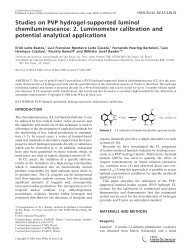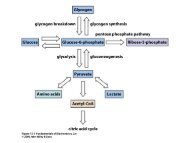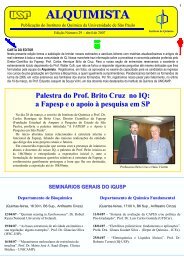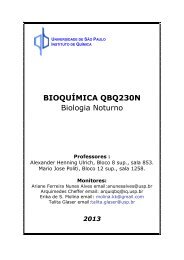Evolution of Sesquiterpene Lactones in Angiosperms*
Evolution of Sesquiterpene Lactones in Angiosperms*
Evolution of Sesquiterpene Lactones in Angiosperms*
You also want an ePaper? Increase the reach of your titles
YUMPU automatically turns print PDFs into web optimized ePapers that Google loves.
162 VICENTE DE P. EMERENClANO, MARIA AUXILIADORA C, KAPLAN AND 01-tO R, GOTTLIEB<br />
Is, O<br />
~0<br />
UO<br />
OLAU<br />
OAPi<br />
OAa~<br />
O.40 O~m~O<br />
I ..... I<br />
O.OO ¢1~0 ~ s O.O0<br />
FIG. 8. CORRELATION OF /~= AND ~o VALUES FOR FAMIUES OF<br />
ANGIOSPERMS CHARAC~RIZED BY THEIR SFGflNE INDEXES (<strong>of</strong>. Table<br />
8). F(x a glossary <strong>of</strong> the th~e-lmt~r ~onyml m Tolde 11.<br />
state (<strong>in</strong> Vemonieae) and skeletal specialization<br />
(<strong>in</strong> Heliantheae) respectively. Reduction <strong>of</strong> oxidation<br />
state and loss <strong>of</strong> skeletal specialization<br />
followed <strong>in</strong> both cases (towards Mutisieae and<br />
Astereae, respectively). This, however, is only a<br />
work<strong>in</strong>g hypothesis. It will be necessary to <strong>in</strong>sert<br />
<strong>in</strong>to this frame other micromolecular data<br />
appear<strong>in</strong>g as replacement characters, <strong>in</strong> order to<br />
arrive at a clearer picture.<br />
F<strong>in</strong>ally, it was deemed desirable to verify the<br />
strength <strong>of</strong> the present analysis <strong>in</strong> face <strong>of</strong> the<br />
permanent flow <strong>of</strong> new <strong>in</strong>formation. A prioriit is<br />
hoped that the system <strong>in</strong>volv<strong>in</strong>g structural types<br />
and averages <strong>of</strong> chemical characters, rather than<br />
s<strong>in</strong>gle compounds, should lead to more durable<br />
conclusions. This seems to be the case.<br />
The present analysis is based on data assembled<br />
by Fischer et al. [2] and by Seaman [3]<br />
which reviewed the literature up to 1982. Table 14<br />
lists 50 species <strong>of</strong> Asteraceae the composition <strong>of</strong><br />
which became known subsequently. A comparison<br />
<strong>of</strong> their sesquiterpene lactone types and<br />
their EA s and EA o parameters with the analogous<br />
data registered <strong>in</strong> Tables 12 and 9 is <strong>in</strong>structive.<br />
Among the eight new species <strong>of</strong> Mutisieae<br />
(Table 14) predom<strong>in</strong>ate compounds <strong>of</strong> type 1, a<br />
feature shared <strong>in</strong>deed by Mutisieae, Vernonieae<br />
and Heliantheae (Table 12). The two latter tribes,<br />
however, are characterized by considerably<br />
higher EA s and EA o values (Table 9). Among the<br />
three new species <strong>of</strong> Vemonieae predom<strong>in</strong>ate<br />
compounds <strong>of</strong> types 1 and 1.3. This feature and<br />
the high EA o values <strong>of</strong> the species are <strong>in</strong>deed<br />
consistent with the general characteristics <strong>of</strong> the<br />
tribe, as well as <strong>of</strong> Eupatorieae and Heliantheae,<br />
the species <strong>of</strong> the latter, however, possess<strong>in</strong>g<br />
higher F_A s values. Among the seven new<br />
species <strong>of</strong> Eupatorieae predom<strong>in</strong>ate aga<strong>in</strong> compounds<br />
<strong>of</strong> type 1.3 and, reciprocally,<br />
differentiation from Vernonieae is difficult. The 10<br />
new species <strong>of</strong> Heliantheae are dist<strong>in</strong>guished, as<br />
~.o(<br />
OvIM<br />
~l[up,<br />
~.LAG~<br />
X<br />
OcA~<br />
BHEU<br />
~H~'l.j<br />
~OmT<br />
~R~<br />
#L Ej~i., r IDA~N<br />
,~<br />
Iollu<br />
IANT<br />
~ e<br />
0.,1~o ~ lEA=<br />
FIG. 9. CORRELATION OF F..A, AND £A= PARAMETERS FOR TRIOES OF ASTERACEAE BELONGING TO THE SUBFAMIUES CIO4ORIOIDEAE (~) AND<br />
ASTEROIDEAE GROUP 1 ~) AND 2 (~|; ANO FOR APIACEAE (X). For a glossary <strong>of</strong> she ~4otmr ac~mtyms ~e Ta~e 12.



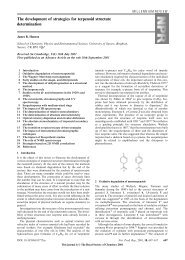
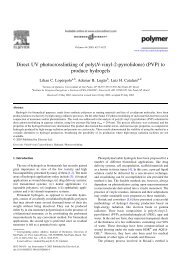
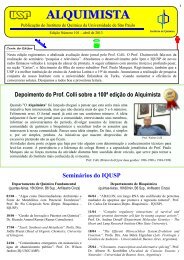
![PE]+ + N. Fragmentação por clivagem sigma](https://img.yumpu.com/50134385/1/180x260/pe-n-fragmentaaao-por-clivagem-sigma.jpg?quality=85)
